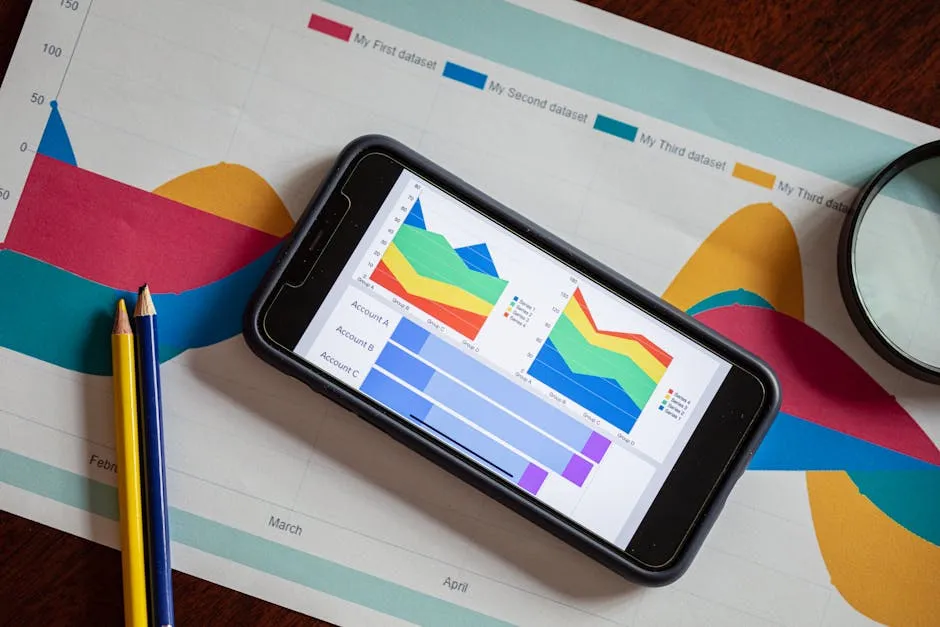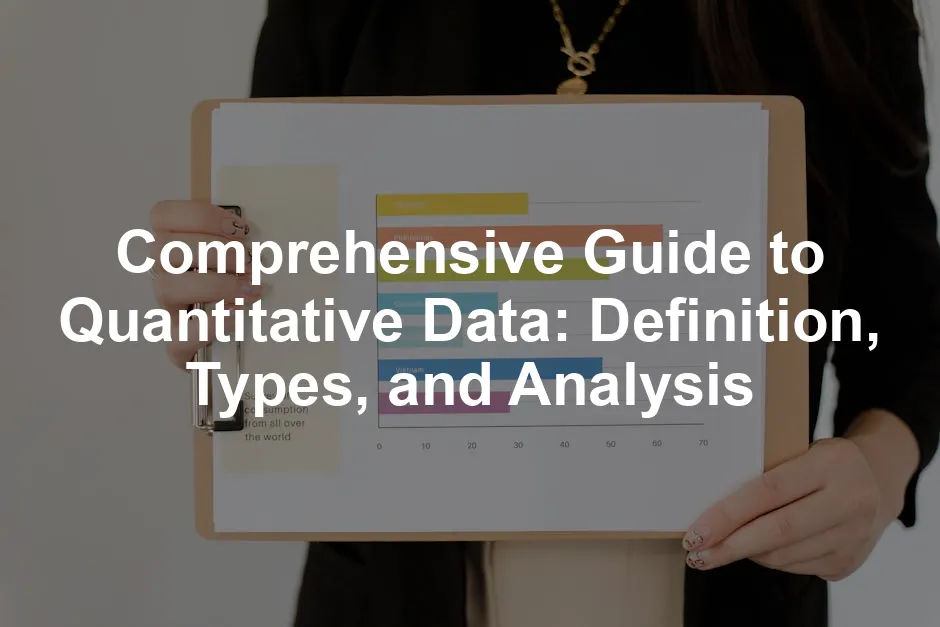Introduction
Are you curious about the power of numbers in research? Quantitative data is essential for making informed decisions. It plays a vital role across multiple fields like business, science, and social research. This article aims to clarify the definitions, types, collection methods, and analysis of quantitative data.
If you’re looking to dive deeper into the world of data science, consider grabbing Statistics for Data Science: Unlocking the Power of Numbers. This book will help you harness the true potential of numbers, turning complex data into actionable insights. It’s like having a cheat sheet for your analytical brain!
Summary and Overview
Quantitative data represents information numerically. It includes anything that can be counted or measured. Its key characteristics are that it is objective and measurable. Understanding quantitative data helps uncover trends and patterns. In this article, we will cover various topics including the types of quantitative data, their advantages and disadvantages, and how to collect them effectively.
To enhance your data analytics skills, you might want to explore The Data Warehouse Toolkit: The Definitive Guide to Dimensional Modeling. This book is a must-have for anyone looking to master data modeling techniques that drive business intelligence.
What is Quantitative Data?
Quantitative data refers to information that can be quantified. It’s all about numbers. This data helps answer questions like “how many,” “how much,” and “how often.” It is crucial for statistical analysis, allowing researchers to test hypotheses and draw conclusions. Types of quantitative data include discrete and continuous data, each serving different purposes. Its numerical representation makes statistical relevance easy to establish, providing a solid foundation for data-driven insights.
For those interested in data analysis using Python, I recommend Python for Data Analysis: Data Wrangling with Pandas, NumPy, and IPython. This book is your gateway to mastering data manipulation and analysis in Python, making your data tasks a breeze!
Characteristics of Quantitative Data
Quantitative data is unique for its objectivity. It revolves around numbers and measurable aspects, making it a reliable choice for analysis. This data type allows researchers to conduct statistical analyses, revealing patterns and trends that can inform decisions. With a strong emphasis on measurement, it’s crucial for the data to be valid. Validity ensures that the information accurately reflects what it is intended to measure.
Moreover, quantitative data’s numerical nature simplifies comparisons and calculations. Think of it as a precise language for understanding the world. Its ability to be analyzed statistically makes it essential in research across various fields. By maintaining objectivity and focusing on measurable outcomes, quantitative data provides a solid foundation for data-driven insights.

Types of Quantitative Data
Understanding the different types of quantitative data is vital. They can be classified mainly into three categories: discrete, continuous, and categorical data.
Discrete Data consists of countable values. For instance, the number of students in a classroom or the votes received in an election. These values are whole numbers, making them easy to quantify.
Don’t miss out on the opportunity to learn more about Naked Statistics: Stripping the Dread from the Data. This book demystifies statistics and makes it accessible, helping you tackle complex concepts with ease.
Continuous Data, on the other hand, includes measurable values that can take any value within a range. This could be height, weight, or temperature. Continuous data is often expressed in decimal form, allowing for more precise measurements.
Categorical Data groups information into categories without a specific numerical value. Consider blood types or types of fruit; while you can count them, they don’t represent a measurable quantity.
Additionally, within these categories, we find Interval Data and Ratio Data. Interval data has equal intervals between values but lacks a true zero point, like temperature in Celsius. In contrast, ratio data includes a true zero, such as weight or height, allowing for meaningful comparisons. Understanding these distinctions helps researchers select the appropriate methods for data collection and analysis, ensuring accurate results.

Collection Methods for Quantitative Data
Collecting quantitative data can be done through several effective methods. Each method has unique strengths and is suitable for different research goals.
Surveys and Questionnaires are popular tools. They allow researchers to gather data from a large audience quickly. Online platforms make it easier to distribute these surveys, often using closed-ended questions for clear, quantifiable responses. Think about those quick polls you see on social media; they provide immediate feedback that can be easily analyzed.
If you’re interested in gaining a deeper understanding of data science techniques, consider checking out Data Science for Business: What You Need to Know about Data Mining and Data-Analytic Thinking. This book will give you the business perspective on data science, making it a great addition to your reading list!
Experiments are another method. In a controlled environment, you can manipulate variables to observe effects. For example, testing new software features with a specific group can yield measurable outcomes. This method is especially useful in fields like psychology and product testing. To understand the fundamentals of experiments, consider the two essential features of all statistically designed experiments.
Understanding the fundamentals of experiments is crucial for effective research. Learn more about the essential features of experiments.
Observations can also collect quantitative data. For instance, counting the number of customers entering a store during peak hours offers concrete numbers. This method can help identify trends over time, such as busy periods or customer behaviors.
Don’t forget about existing datasets or secondary data. Analyzing previously collected information can save time and resources. This could include government statistics or studies from other researchers. Using established datasets often allows for broader insights without starting from scratch.
Sample selection and design are vital for validity. A well-chosen sample ensures that the data truly represents the larger population. Poor sample selection can lead to skewed results, making your conclusions unreliable. Therefore, always prioritize thoughtful and strategic sampling methods to enhance the quality of your quantitative research.

Analysis of Quantitative Data
Analyzing quantitative data is crucial for extracting meaningful insights. Various methods can help you understand and interpret the numbers.
Descriptive statistics are often the starting point. This includes calculating the mean, median, and mode. These measures summarize the data, giving a clear picture of central tendencies. For instance, knowing the average sales figures can help a business understand its performance better. For a comprehensive guide on descriptive statistics in manufacturing, check out descriptive statistics in manufacturing plant.
Descriptive statistics provide a foundational understanding of data analysis. Explore the comprehensive guide on descriptive statistics in manufacturing.
Then, we have inferential statistics. This method allows researchers to make predictions or generalizations based on sample data. Techniques like hypothesis testing help determine if observed patterns are statistically significant. Regression analysis can also show relationships between variables, like how advertising spend influences sales. However, it’s important to be aware of the problem with inferential statistics when interpreting results.
Be cautious with inferential statistics as they can lead to misleading conclusions. Learn more about the problems associated with inferential statistics.
When it comes to tools for analysis, several popular options exist. R and Python are robust programming languages widely used for statistical analysis. They offer powerful libraries for handling and visualizing data. Excel remains a staple for many due to its accessibility and user-friendly interface. It may not be as powerful as R or Python, but it’s perfect for quick analyses and visualizations. If you’re keen on mastering Excel, check out Excel 2019 Power Programming with VBA. This book will elevate your Excel skills to a whole new level!
Lastly, data cleaning and preparation are crucial steps. Raw data often contains errors or inconsistencies that can skew results. Taking the time to clean and organize your data ensures accuracy in the analysis process. Proper preparation allows for more reliable conclusions and insights, making your research more impactful.

Advantages of Quantitative Data
Quantitative data offers several key benefits that make it a valuable tool for researchers and decision-makers. First and foremost, it is known for its objectivity and reliability. Since it is based on numerical values, the results can be verified and replicated by others, which enhances trustworthiness. This objectivity minimizes personal biases, ensuring that conclusions are drawn from facts rather than opinions.
Another significant advantage is the ability to generalize results. When researchers collect data from a well-chosen sample, they can make inferences about a larger population. This is particularly useful in fields like marketing and social science, where understanding trends can drive strategies. To further enhance your understanding of this topic, Data Science for Dummies is a fantastic resource that breaks down these concepts in an easy-to-understand manner.
Lastly, quantitative data collection and analysis methods are often efficient. Surveys and automated tools allow for the swift gathering of large datasets. This efficiency means that organizations can quickly adapt to changes in data, leading to timely and informed decisions. By leveraging these advantages, businesses and researchers can harness the full potential of quantitative data to guide their initiatives.

Disadvantages of Quantitative Data
While quantitative data has its strengths, it also comes with limitations that researchers must consider. One major drawback is the potential for oversimplification. Complex issues often require nuanced understanding, which numbers alone cannot provide. This oversimplification can lead to important details being overlooked.
Another challenge is the lack of context and depth. Quantitative data often misses the “why” behind the numbers, leaving out the emotional and situational factors that influence behavior. For instance, a survey may show that 70% of customers are satisfied, but it won’t explain the underlying reasons for their satisfaction. To explore more about these underlying factors, consider reading The Art of Statistics: Learning from Data, which dives into the deeper implications of data.
Lastly, there’s a risk of misinterpretation. Poor sampling methods or flawed questions can skew results, leading to incorrect conclusions. This risk emphasizes the importance of careful design and execution during the data collection process. Researchers must remain vigilant to ensure that their interpretations accurately reflect reality.

Differences Between Quantitative and Qualitative Data
Understanding the differences between quantitative and qualitative data is crucial for effective research. Quantitative data is numerical, focusing on measurable quantities, while qualitative data is descriptive, emphasizing the richness of human experience. This fundamental difference shapes how each type is used in research.
The objectives of research also differ between the two. Quantitative research aims to measure and establish patterns, answering questions like “how much” or “how many.” In contrast, qualitative research seeks to understand underlying motivations and feelings, exploring “why” people behave in certain ways.
When it comes to methods of collection, quantitative data is typically gathered through structured surveys and experiments. These methods yield numerical results that can be statistically analyzed. In contrast, qualitative data is usually collected through interviews, focus groups, or open-ended surveys, allowing for deeper insights into participants’ thoughts and feelings.
In summary, while quantitative data excels in providing measurable and generalizable results, qualitative data offers context and depth. Each type has its place in research, and combining both can lead to a more comprehensive understanding of a given topic.

Conclusion
In this article, we covered the essentials of quantitative data. We defined it as numerical information used to measure and analyze various phenomena. Understanding this data type is crucial for making informed decisions in research and business. It plays a significant role in identifying patterns and trends, helping you draw accurate conclusions.
Remember, while quantitative data provides valuable insights, it’s important to also consider qualitative data. By balancing both types, you can achieve a more comprehensive analysis. So, the next time you gather data, think about how these two approaches can work together to enhance your understanding. For those looking for a comprehensive guide to data analysis, I highly recommend The Data Science Handbook: A Comprehensive Guide to Data Analytics. It’s an invaluable resource for anyone serious about data analysis!

FAQs
What is quantitative data?
Quantitative data refers to numerical information that can be counted or measured. Examples include age, income, or test scores.
How is quantitative data collected?
It can be collected through surveys, experiments, observations, and existing datasets.
What are the differences between quantitative and qualitative data?
Quantitative data is numerical and focuses on measurements, while qualitative data is descriptive and explores characteristics or experiences.
What are the advantages of using quantitative data?
Quantitative data is objective, allows for statistical analysis, and can be generalized to larger populations.
In what fields is quantitative data commonly used?
It is used across various industries, including business, healthcare, education, and social sciences.
What tools can be used for quantitative data analysis?
Common tools include Microsoft Excel, R, Python, and specialized software like Tableau.
What are some challenges of quantitative data?
Challenges include potential oversimplification of complex issues, lack of context, and risk of misinterpretation.
Please let us know what you think about our content by leaving a comment down below!
Thank you for reading till here 🙂
All images from Pexels




